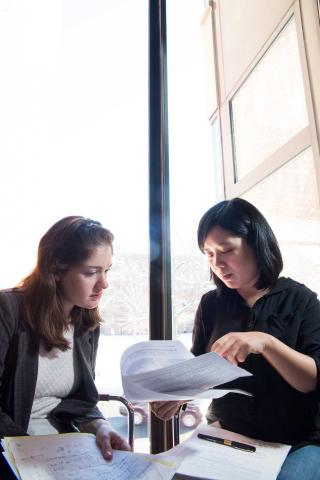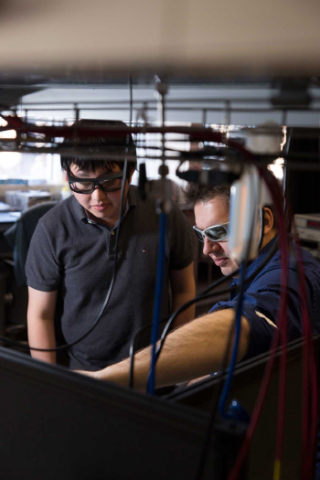Throughout its 170 year history—and under several different names—the Harvard John A. Paulson School of Engineering and Applied Sciences has continued to make pathbreaking advances, many of which build on the research of Graduate School of Arts and Sciences (GSAS) alumni in engineering and applied sciences.

In 1847, Abbot Lawrence, a mill owner in the eponymous city of Lawrence, Massachusetts, donated $50,000 to Harvard University for the establishment of an advanced scientific school. Driven in part by his friendship with Harvard President Edward Everett, Lawrence wanted to address what he saw as a lack of individuals trained in the “practical applications of science” whom he could hire to work at his mill. The resulting Lawrence Scientific School—which would undergo multiple transformations from a graduate school in applied sciences to the Harvard Engineering School and the Division of Engineering and Applied Sciences before coming full circle as the Harvard John A. Paulson School of Engineering and Applied Sciences—was founded on the idea of building a professional school where advances would not be made in a vacuum, but rather provide inspiration for the work of those who would come later.
Inventive men laboriously reinvent what has been produced before,” Lawrence wrote at the time of his donation. “Ignorant men fight against the laws of nature with a vain energy, and purchase their experience at great cost. Why should not all these start where their predecessors ended, and not where they began?
What’s the Frequency?
Less than 50 years later, George Washington Pierce made his way from Texas to Boston—apocryphally—as a wrangler on a cattle train. Having completed a bachelor’s degree and a master’s in physics at the University of Texas, he decided to continue his studies at Harvard and within two years earned a second master’s and a PhD, graduating in 1900. After study in Europe, he returned to join Harvard’s faculty and taught physics from 1903 to 1940 while conducting multiple research projects, some of which would lay the foundation for electrical communication—most famously the Pierce Oscillator.
By the 1920s, radio had become a prime means of communication for ordinary Americans, who began tuning in for their entertainment and news. As a result, the airwaves became crowded, leading to radio interference that interrupted broadcasts. While devices existed to counteract this “drifting” into other frequencies, they were not always practical to use. Pierce saw potential in the piezoresonator, which had the capacity to control frequencies. Simplifying the design and adding several modifications, he developed the Pierce Oscillator, which could easily be added to medium wave and shortwave radios to ensure that a broadcast remained in its transmitted frequency. His innovation led to advances in radio, telephony, and more.
Tiny Radio
In a basement lab in the Gordon McKay building, Linbo Shao checks the connections leading to a golden metal plate placed beneath a microscope. On the bench in front of him, several monocle-sized lenses direct a beam of green light in a zigzag pattern while another lens placed near the microscope is fixed on a tiny device imbedded in the center of the plate.
To make such a unique device, Shao takes advantage of defects inside the diamond that are formed by removing one carbon atom and replacing a second with a nitrogen atom. This creates a nitrogen-vacancy (NV) center—basically a nitrogen atom next to an empty space—that can sense radio waves. Shao uses green laser light to power the NV center, which then receives the FM signal from his laptop, converts it, and emits it as red light. The light is further converted to a current by a semiconductor and amplified as sound through the speaker.
Based in the lab of Marko Lončar, the Tiantsai Lin Professor of Electrical Engineering, Shao enjoys working in an applied physics environment, a departure from his studies of microelectronics as an undergraduate at Peking University. He aims to expand his knowledge of physics during his graduate career, and the radio gave him the perfect opportunity to test a complex quantum physics phenomenon. “I’m an engineering guy in an applied physics group,” he smiles. “Usually I’m looking to find interesting applications for my work.”
Lončar gave Shao his full support. “I think the combination of engineering and demonstration in this project is pretty cool,” he shares.
It’s the smallest possible radio receiver you can ever make.
What began as a cool idea has turned into something with implications beyond the transmission of music.
In addition to being the hardest naturally occurring mineral, diamonds have properties that make them ideal candidates for other applications. They can withstand extreme heat and cold, for example, and are also compatible with living tissue. This means that they are the perfect material for researchers who are developing instruments to be used in space, in deep-sea hydrothermal vents, or in the human body. Soon after Shao and Lončar published the results of this experiment in the journal Physical Review Applied, they heard from optogenetic researchers at Harvard interested in developing biosensors that could be implanted in human tissue and controlled by microwave signals.
Even though they have finished with their radio experiment for now, Shao and Lončar continue to develop the technology, considering applications that will, among other things, impact cybersecurity. “Since the radio is a kind of microwave, I’m adapting it for use in a mobile phone,” Shao explains. “I want to create a sensor that will alert users if their device is compromised.”
Lončar also sees the potential for combatting insidious security breaches that are not picked up by standard virus software, such as hardware Trojans— the deliberate modification of an integrated circuit for malicious purposes. “With computer chips being manufactured globally, it is easy for someone to add a piece to the hardware that is designed to monitor what the computer does,” he says. “Adding a sensor could measure increases in processing activity at unexpected times and warn of possible hacking.”
Power Up
American desire for easily accessible entertainment and news has not waned since Pierce patented his oscillator. In the 21st century, we expect immediate access to the information we want, often in the palms of our hands. Whereas in the 1920s, finding a way to stabilize a signal was important, nowadays, ensuring that enough power is available to handle the proliferation of devices is now of paramount concern.
And this aim is becoming increasingly challenging. Little has changed from the generation and transmission systems developed in Pierce’s time, which delivered the electricity needed to light a home or power a radio. Today, increasingly sophisticated appliances, smartphones, and computers tax an energy grid decades old and unprepared to handle the two-way communication and intermittent energy production of renewable sources like wind and solar.
“Traditionally, a few large and easily controlled conventional power plants provided energy that was transmitted to end users,” explains Ariana Minot, a PhD student in applied mathematics.
One of the big challenges for the power grid today is that there’s more and more power production being done at the distribution level of the grids.
The solar panels on your house, your electric car, the small-scale wind farms being built, all are developing the potential for a two-way power flow not envisioned by those who planned our current energy generating and distribution system.
 Minot came to Harvard interested in studying power grids, driven in part by her desire to apply analytical approximations to real systems. When she learned that a researcher interested in the topic was about to join the SEAS faculty, she reached out and later joined her lab. Na Li, assistant professor in electrical engineering and applied mathematics, is tackling a challenging technological problem: how to design intelligent and self-sufficient power grids that will be able to handle the coming connected world.
Minot came to Harvard interested in studying power grids, driven in part by her desire to apply analytical approximations to real systems. When she learned that a researcher interested in the topic was about to join the SEAS faculty, she reached out and later joined her lab. Na Li, assistant professor in electrical engineering and applied mathematics, is tackling a challenging technological problem: how to design intelligent and self-sufficient power grids that will be able to handle the coming connected world.
“Working on the power grid and electrical management is a good starting point for envisioning the smart cities of the future,” says Li. “How can different systems affect and help each other?” Li sees a world where smart urban planning can reduce energy consumption while benefiting citizens, for example, by using sensors to detect traffic and turn on streetlights to light the way, then powering them down when no longer necessary. In addition to saving energy, the sensors would accumulate data to help predict peak usage times, to effectively inform the generation of electricity. “Such a connected community will give the system a better way to know what’s happening, and when.”
Much of the work accomplished by Li and Minot concerns the development of algorithms aimed at predicting the most efficient method for distributing energy, whether it is generated traditionally through power plants or through renewable sources, and then testing them on real systems. Because the system currently estimates usage through one central control area of the grid, Minot focuses on how to make the system more resilient and able to make estimations at more local levels. In an article they co-published in fall 2016, Minot and Li proposed an algorithm that demonstrated improved state estimation of power systems, one step closer to developing a power grid that supports Li’s vision of a connected future. “I hope in a decade or two we can say we are really living in the future, in that smart neighborhood,” she smiles.
New Ideas
One hundred and seventy years ago, Abbott Lawrence envisioned a place where research would not be conducted in a vacuum, but rather in an environment of collaboration and ongoing development. Pierce’s improvement to the piezoresonator ultimately built a better radio. Shao and Lončar’s two-atom radio created a transmitter with numerous applications. Minot and Li strive to create systems that enable technological advances to succeed in a sustainable way. Other SEAS researchers start with ideas that would have seemed fantastical when Lawrence made his gift. Soft robots, lungs on a chip, a robot that helps a heart beat—all exciting developments taking place in an interdisciplinary environment. Lawrence’s vision and investment have borne fruit, and have assured that Harvard’s engineering school remains a place of constant innovation.
Illustration by Dave Plunkert; Photos by Mark Ostow
This article originally appeared on the Graduate School of Arts and Sciences (GSAS) website.
Engineering and Applied Sciences at Harvard Reunion & Symposium for Graduate Alumni
The year 2017 marks the 170th anniversary of the Lawrence Scientific School at Harvard, and the 10th anniversary of the establishment of the now Harvard John A. Paulson School of Engineering and Applied Sciences from the Division of Engineering and Applied Sciences. The reunion program celebrates the history, scholarship, and future of engineering and applied sciences at Harvard.
Friday, April 7, 2017 I 10 a.m.
Location:
United States
 Shao, a PhD student in engineering sciences, powers up a portable speaker, turns to his laptop, and taps a few keys. Viewed through the lens, the device emits a red light as the theme from Star Wars plays through the speakers. The device is an assembly of two atom-sized radio receivers, transmitting from the center of a pink diamond.
Shao, a PhD student in engineering sciences, powers up a portable speaker, turns to his laptop, and taps a few keys. Viewed through the lens, the device emits a red light as the theme from Star Wars plays through the speakers. The device is an assembly of two atom-sized radio receivers, transmitting from the center of a pink diamond.